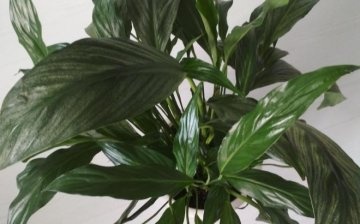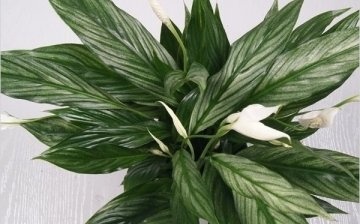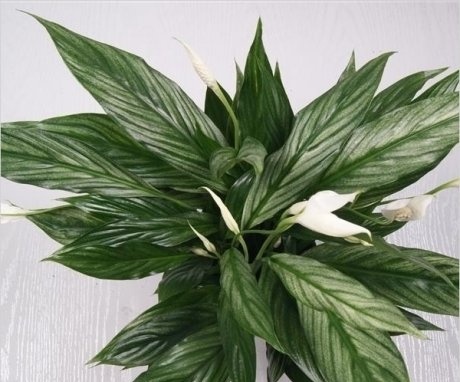Spathiphyllum variety "Silver Cupido" - growing in the room and flower reviews
"Silver Cupid" or "Silver Cupido" is a popular variety of spathiphyllum. Bright green leaves, chiseled white flowers create a stunning combination. In addition to its beauty, spathiphyllum has a valuable quality - it cleans the air in the room well. In addition, it is an unpretentious variety, easy to care for and blooming for a long time.
What is this grade
While creating indoor flower Spathiphyllum Dutch breeders used natural species such as Wallis' Spathiphyllum and existing hybrids. The Latin name of the variety is "Silver Cupido". "Silver Cupido" attracts attention with luscious green foliage, gracefully curved white bedspreads of inflorescences.
Description and characteristics
Spathiphyllum is a genus of evergreen plants of the Aroid family, imported from the tropical regions of Colombia. Habitat - coastal areas of evergreen forests. The first mentions of this flower appeared in the 19th century after the discovery of the plant by the German scientist Wallis. In total, there are over 40 species of the genus Spathiphyllum in the world. Only a few species are adapted to domestic conditions.
Description:
- An adult houseplant reaches a height of 40-50 cm.
- Large simple elliptical leaves 15 to 20 cm long have an elongated petiole (10-15 cm).
- Leaves emerge directly from the soil where the short rhizome (modified stem) is located.
- The general color of the leaves is intense green, the surface is leathery, smooth. There are silvery stripes and dots along the veins.
- At a young age, the leaves grow vertically, at a mature age they bend beautifully in an arc.
- A flower is a white veil (a modified leaf blade) with a yellowish cob-shaped inflorescence in the center.
On a note. The bush of the Silver Cupido variety is compact and easy to care for, it remains fresh all year round, and retains the bright green color of its foliage.
What it looks like, how it blooms
The two-color variety "Silver Cupido" has a color unusual for natural spathiphyllums. Against the general green background of the leaves, silvery areas around the veins stand out. Due to the unusual color combination, the plant was named "Silver Cupido", which means "Silver Cupid".
Spathiphyllum literally means "white sheet". The so-called spathiphyllum flower is a veil (modified leaf blade) with an inflorescence-cob in the center. People call this indoor flower "female happiness".
An inflorescence with a white veil looks spectacular among large leaves. The tip of the coverlet is pointed and colored green. An ear of yellow or creamy yellow color, 7–13 cm long, 4–4.5 cm in diameter. The aroma is delicate, sweet. During flowering, the whole plant looks unusual, elegant, graceful.
In spring, up to 10 inflorescences bloom sequentially, several can bloom at the same time. Life expectancy in indoor conditions is from 3 to 5 years, sometimes the plant retains its decorative appearance for 10 years. The neat spathiphyllum bushes in the optimal environment bloom from April to May or longer.
Subspecies of the variety ("Variegated", "Compact" and others)
In addition to Silver, there are other well-known and recently created hybrids in the Cupido series: Pronto, Pearl, Bingo, Coco, Cosmic, Pico, Romeo.
Spathiphyllum "Compacto Cupido" has large green leaves.They are shiny, leathery, without light spots or stripes. "Compact Cupido" blooms profusely. Three large creamy white “flowers” with a yellow spikelet in the center appear on the plant at the same time. The bedspread is pointed.
"Variegated" - a rare hybrid, notable for the fact that the leaves are variegated in color. Groups of cells in leaf tissue do not have chlorophyll, therefore they stand out against the general background. You can recognize the variety by the light longitudinal vein. The total height of the plant is from 40 to 60 cm. The leaves are wider than that of the Silver Cupid. The smell during flowering is enhanced in the morning.
Pearl is a variegated variety similar to Silver Cupido. It grows well at home, it blooms luxuriously with proper care. Varieties of the Cupido series - Bingo, Romeo, Pronto - are similar. Plants have bright green leaves, white bedspreads with a yellow cob.
Coloring of variegated varieties of spathiphyllum "Domino", "Picasso" is a scattering of small and large white spots, stripes of different lengths on green leaves. They give an additional decorative look to variegated plants that look advantageous against the background of the monochromatic foliage of other indoor flowers.
Favorable growing conditions
Spathiphyllum - an unassuming houseplant. If you find a suitable place in the room from the very beginning, then for a long time it will delight you with bright green leaves and long flowering.
Temperature
Indoor plants native to the tropics cannot stand the cold. The temperature range for thermophilic green room dwellers is from 18 to 28 ° C. Spathiphyllum is not recommended to be taken out to an open balcony or terrace. The plant can hardly tolerate sudden changes in conditions, temperature drops. Optimal conditions - temperature from 19 to 25 ° С, permanent location.
During the flowering period, the air temperature should be from 21 to 24 ° C. After the end of flowering, the spathiphyllum needs rest. This is not a full-fledged dormant period, since the leaves of the plant remain alive, green, juicy. The favorable temperature of the content during this period is 16–18 ° С. Spathiphyllum can be stimulated to bloom profusely in spring if from October to February – March the pot with the plant is on a window in a cool room or on a northern windowsill.
Shine
Sort "Silver Cupid" needs diffused lighting, feels good on north-facing windows. However, with a lack of light, the leaves lose silvery spots and stripes, and become monotonously green. Also, do not expect abundant flowering of spathiphyllum in low light.
Green plants are rotated from time to time to avoid one-sided bending of the leaves towards the light source. "Silver Cupido" can be rotated, moved to another place only after flowering. It is better not to touch until the flowers appear.
If the pot is on the south, east or west window, then it needs shading at noon from direct sunlight. The ideal place for a houseplant is west or east orientation windows. Spathiphyllum, which is located at a distance of 2 m from a window or in the back of the room, does not bloom, the leaves stretch out.
Air humidity and watering
Adequate amount of water is one of the main rules for caring for spathiphyllum. Watering should be regular but moderate. At high air temperatures, the plant needs more moisture. If the surface of the soil dries up during the day, then watered daily. In cool weather, watering 1-2 times a week is sufficient.
Advice. The soil in the pot should be kept evenly moist, but not wet. In a swampy substrate, the roots and leaf petioles begin to rot.
Spathiphyllum leaves are regularly sprayed with soft water at room temperature. You can shower the plant by flushing the accumulated dust with a spray from the spray. The excess water evaporates from the leaves. This process sometimes occurs so intensely that drops appear on the tips of the leaves.
Top dressing
Fertilizers are applied in spring and during the entire flowering period. The plant needs feeding once every 2 weeks. Use standard potting fertilizer mixtures. The amount of powder or granules indicated on the package is dissolved in warm water. Top dressing is carried out only after watering the plant.
Fertilizers containing phosphorus and potassium stimulate flowering. Nitrogen fertilization helps to increase the size of the leaves. The rapid growth of spathiphyllum is stimulated by liquid feeding with a solution of urea.
Usually, complex fertilizers with basic nutrients and microelements, organic additives go on sale. Only 1–2 g of the nutrient mixture is dissolved in 1 liter of water. In autumn and winter, the plant is not fed.
How to grow at home
A spectacular decorative look allows the plant to be used to decorate any interior. Spathiphyllum is equally quickly mastered in residential and office conditions.
Preparation (containers, soil, planting material)
Spathiphyllum is grown in a medium-sized pot. Narrow and shallow containers are not suitable, there is little room for the rhizome and the regrowth of new leaves. The material from which the pot is made can be anything (ceramics, plastic).
It is important to choose the "correct" soil for the spathiphyllum. Suitable neutral substrates with pH values in the range of 6-7. The soil should be fresh, loose, well-permeable to air and water. You can buy ready-made soil for indoor flowers, enriched with peat, filled with fertilizers, with the addition of vermiculite.
Spathiphyllum planting material is young plants or "delenki" with leaves obtained by cutting the rhizome of an adult mother plant.
Planting instructions
The procedure is simple and accessible, but requires accuracy and consistency.
Procedure:
- Pour a 2 cm high drainage on the bottom of a previously prepared container. Use expanded clay, pebbles, pieces of foam (one of the materials).
- Pour the prepared substrate onto the drainage layer so that it takes up about one or two-thirds of the pot.
- Water the soil and place the spathiphyllum rhizome in the center of the pot.
- Fill the roots with the remaining substrate, lightly tamp with a spatula.
- Water liberally.
Advice. It is possible that in the following days after planting, the soil in the pot will settle. In this case, add some substrate around the leaves.
Further care
After planting, the leaves are sprayed and covered with a plastic bag for 4–5 days. Leave the pot not on the windowsill, but away from the window. After the spathiphyllum has taken root, the shelter is removed. Place the pot on a well-lit windowsill in a warm room.
Advice. Water more abundantly in summer, reduce watering in autumn. It is useful to temporarily place the plant in a cool room to stimulate the growth of the peduncles.
Spathiphyllum bloom lasts about 4-10 weeks. After that, rest is required to lay new flower buds. Withered peduncles are cut off, deformed and yellowed leaves are removed. The petioles are cut off at the very surface of the substrate.
Spathiphyllum needs a transplant in the spring every 2 years. You can do a transshipment. To do this, completely remove the root ball from the old pot, do not divide it, place it entirely in a container that is larger in diameter than the previous one. Cover the free space with fresh substrate. To make the leaves larger, lateral processes can be removed during transplanting and handling.
Reproduction
The easiest way to get a new plant of the same variety that you liked attracted the attention of a grower - dividing the bush. This procedure is carried out in the spring. First, water the soil in the pot. Then the root ball is taken out and cleaned of soil. Cut the rhizome into two or more parts. It is necessary to divide the mother bush so that the daughter plants have well-developed leaves, young roots and lateral buds.
Places of cuts are treated with wood ash or activated carbon. The pot is taken 2 cm wider than the size of the "delenka" rhizome. Planting is carried out in the same way as described above in the instructions.
Sowing seeds of spathiphyllum is not practiced by lovers of indoor plants, since with this method the characteristics of the variety may be lost. Seed propagation is used by specialists in nurseries to obtain a large number of young plants.
Protection against diseases and pests
Spathiphyllum "Silver Cupido", as a rule, is not very susceptible to diseases and pests. The most common pathologies are Phytophthora, affecting leaves, Cylindrocladium and Pythium root rot. They are treated against these diseases with fungicidal preparations for indoor plants.
Spathiphyllum pests are scale insects and aphids. The "bugs" are washed off with a stream of water or the leaves are washed with a solution of laundry soap. Cover the pot with the substrate to prevent soap from getting into the soil. Ticks can also be washed off with soapy water with the addition of tobacco leaves.
If there are many pests, then they are treated with an insecticide solution. There are several brand names of drugs that are intended for indoor plants. You can spray with a solution of a strong pesticide Actellik, for which the plant must be taken out for several hours outside or in a non-residential building.
Advantages and disadvantages of the variety
Spathiphyllum "Silver Cupido" easily adapts to life in houses and apartments. It grows well at a temperature of about 23 ° C, blooms in spring, the whole year pleases with juicy green leaves with silvery veins. Caring for the plant is simple, even a novice florist can handle it.
Spathiphyllum took part in the Clean Air study. Scientists have found that the plant cleans indoor air from pollutants, including benzene and formaldehyde. Leaves absorb various harmful substances during respiration and photosynthesis. The toxins enter the root, where they are broken down and rendered harmless.
During the day, the plant absorbs carbon dioxide from the air and emits oxygen, the volume of which is the greater, the larger the size and number of leaves. Water vapor is released through the stomata. The air in the room where the spathiphyllum is located is cleaner and more humid. But how many plants do you need to improve the microclimate of one room?
Researchers of the Clean Air program have calculated that 15-18 spathiphyllum bushes are enough for 180 m3 of area. Scientists have also found out the positive effect of this plant on the mental state of a person.
Spathiphyllum is conditionally safe for humans and animals when ingested. Calcium oxalate crystals when chewing and swallowing leaves can cause irritation of the mucous membranes, burning sensation in the mouth, difficulty swallowing, and nausea.
The plant does not contain toxins, like some indoor plants, does not lead to poisoning and kidney failure in tetrapods and tailed lovers of juicy greenery of indoor flowers.
Reviews
-
Olga:
“Spathiphyllum is interesting to me because it looks beautiful in the room and does not require much attention. I would like to have different varieties in order to compare and get several flowering plants. "
-
Vadim:
“My spouse is engaged in indoor flowers, she introduces me. I noticed the unusual color of the leaves. I was told it was Silver Cupido spathiphyllum. An interesting flower that decorates the room. "
-
Elena:
“I like many varieties of Spathiphyllum, but more like plants with variegated leaves. It is said to be a variegated coloration associated with a mutation. Such "mutants" to my liking! "
Video about the best varieties of Spathiphyllum:












Judging by the description, Spathiphyllum is a beautiful, useful and very unpretentious plant to grow. For the office, this is, directly, an ideal option, yes, and in home interiors, the flower will fit perfectly.